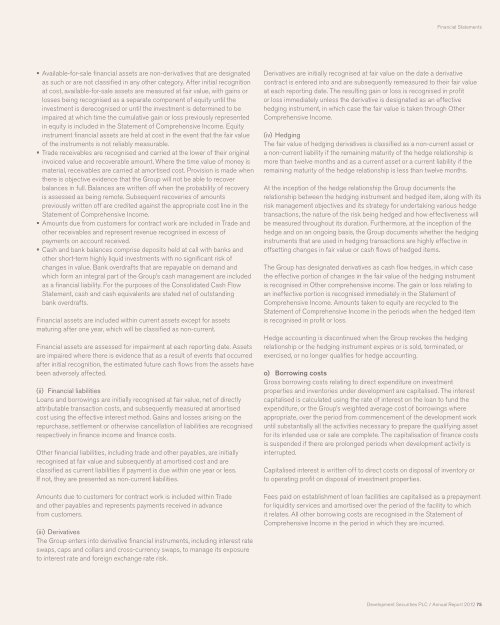Annual Report 2012 - Development Securities PLC
Annual Report 2012 - Development Securities PLC
Annual Report 2012 - Development Securities PLC
You also want an ePaper? Increase the reach of your titles
YUMPU automatically turns print PDFs into web optimized ePapers that Google loves.
Available-for-sale financial assets are non-derivatives that are designated<br />
as such or are not classified in any other category. After initial recognition<br />
at cost, available-for-sale assets are measured at fair value, with gains or<br />
losses being recognised as a separate component of equity until the<br />
investment is derecognised or until the investment is determined to be<br />
impaired at which time the cumulative gain or loss previously represented<br />
in equity is included in the Statement of Comprehensive Income. Equity<br />
instrument financial assets are held at cost in the event that the fair value<br />
of the instruments is not reliably measurable.<br />
Trade receivables are recognised and carried at the lower of their original<br />
invoiced value and recoverable amount. Where the time value of money is<br />
material, receivables are carried at amortised cost. Provision is made when<br />
there is objective evidence that the Group will not be able to recover<br />
balances in full. Balances are written off when the probability of recovery<br />
is assessed as being remote. Subsequent recoveries of amounts<br />
previously written off are credited against the appropriate cost line in the<br />
Statement of Comprehensive Income.<br />
Amounts due from customers for contract work are included in Trade and<br />
other receivables and represent revenue recognised in excess of<br />
payments on account received.<br />
Cash and bank balances comprise deposits held at call with banks and<br />
other short-term highly liquid investments with no significant risk of<br />
changes in value. Bank overdrafts that are repayable on demand and<br />
which form an integral part of the Group’s cash management are included<br />
as a financial liability. For the purposes of the Consolidated Cash Flow<br />
Statement, cash and cash equivalents are stated net of outstanding<br />
bank overdrafts.<br />
Financial assets are included within current assets except for assets<br />
maturing after one year, which will be classified as non-current.<br />
Financial assets are assessed for impairment at each reporting date. Assets<br />
are impaired where there is evidence that as a result of events that occurred<br />
after initial recognition, the estimated future cash flows from the assets have<br />
been adversely affected.<br />
(ii) Financial liabilities<br />
Loans and borrowings are initially recognised at fair value, net of directly<br />
attributable transaction costs, and subsequently measured at amortised<br />
cost using the effective interest method. Gains and losses arising on the<br />
repurchase, settlement or otherwise cancellation of liabilities are recognised<br />
respectively in finance income and finance costs.<br />
Other financial liabilities, including trade and other payables, are initially<br />
recognised at fair value and subsequently at amortised cost and are<br />
classified as current liabilities if payment is due within one year or less.<br />
If not, they are presented as non-current liabilities.<br />
Amounts due to customers for contract work is included within Trade<br />
and other payables and represents payments received in advance<br />
from customers.<br />
(iii) Derivatives<br />
The Group enters into derivative financial instruments, including interest rate<br />
swaps, caps and collars and cross-currency swaps, to manage its exposure<br />
to interest rate and foreign exchange rate risk.<br />
Financial Statements<br />
Derivatives are initially recognised at fair value on the date a derivative<br />
contract is entered into and are subsequently remeasured to their fair value<br />
at each reporting date. The resulting gain or loss is recognised in profit<br />
or loss immediately unless the derivative is designated as an effective<br />
hedging instrument, in which case the fair value is taken through Other<br />
Comprehensive Income.<br />
(iv) Hedging<br />
The fair value of hedging derivatives is classified as a non-current asset or<br />
a non-current liability if the remaining maturity of the hedge relationship is<br />
more than twelve months and as a current asset or a current liability if the<br />
remaining maturity of the hedge relationship is less than twelve months.<br />
At the inception of the hedge relationship the Group documents the<br />
relationship between the hedging instrument and hedged item, along with its<br />
risk management objectives and its strategy for undertaking various hedge<br />
transactions, the nature of the risk being hedged and how effectiveness will<br />
be measured throughout its duration. Furthermore, at the inception of the<br />
hedge and on an ongoing basis, the Group documents whether the hedging<br />
instruments that are used in hedging transactions are highly effective in<br />
offsetting changes in fair value or cash flows of hedged items.<br />
The Group has designated derivatives as cash flow hedges, in which case<br />
the effective portion of changes in the fair value of the hedging instrument<br />
is recognised in Other comprehensive income. The gain or loss relating to<br />
an ineffective portion is recognised immediately in the Statement of<br />
Comprehensive Income. Amounts taken to equity are recycled to the<br />
Statement of Comprehensive Income in the periods when the hedged item<br />
is recognised in profit or loss.<br />
Hedge accounting is discontinued when the Group revokes the hedging<br />
relationship or the hedging instrument expires or is sold, terminated, or<br />
exercised, or no longer qualifies for hedge accounting.<br />
o) Borrowing costs<br />
Gross borrowing costs relating to direct expenditure on investment<br />
properties and inventories under development are capitalised. The interest<br />
capitalised is calculated using the rate of interest on the loan to fund the<br />
expenditure, or the Group’s weighted average cost of borrowings where<br />
appropriate, over the period from commencement of the development work<br />
until substantially all the activities necessary to prepare the qualifying asset<br />
for its intended use or sale are complete. The capitalisation of finance costs<br />
is suspended if there are prolonged periods when development activity is<br />
interrupted.<br />
Capitalised interest is written off to direct costs on disposal of inventory or<br />
to operating profit on disposal of investment properties.<br />
Fees paid on establishment of loan facilities are capitalised as a prepayment<br />
for liquidity services and amortised over the period of the facility to which<br />
it relates. All other borrowing costs are recognised in the Statement of<br />
Comprehensive Income in the period in which they are incurred.<br />
<strong>Development</strong> <strong>Securities</strong> <strong>PLC</strong> / <strong>Annual</strong> <strong>Report</strong> <strong>2012</strong> 75






